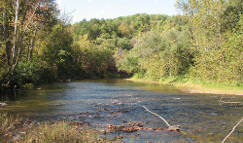

|
From left to right, the Big Piney River above Ross Bridge, deer grazing in a field along Maramec Spring Branch, and the wild trout portion of Blue Spring Creek
|
|
One of the littlest known trout fishery in the Ozark hills is the small wild trout streams that lace southern Missouri. These streams get a relatively small amount of fishing pressure, and they provide excellent fishing. But they aren't for everyone. It takes a lot of work, and a bit of skill to take these stream-bred trout. If you like easy fishing for hatchery raised trout, chances are you'll only be frustrated. If you enjoy being on a quiet, natural stream, and catching trout on their own terms, you’ll really enjoy this type of fishing. Tactics are pretty universal for catching the wild rainbows that inhabit these small streams. In short, you want to imitate the natural food base. For that reason, if there is a hatch, fly fisherman that are imitating the natural food source generally take more fish than others. When fish aren't rising, spin fisherman, or fly anglers tossing streamers or nymphs will do quite well. In short, you have to know what the trout are feeding on at that particular moment to be successful. Stealth may be an even more important element of success. If you spook the trout before you begin fishing, it won't matter how enticing your offering is. When you come up on a likely run, wade quietly (i.e. do not step heavily or crunch gravel), and try to keep your profile down. Some even approach on their hands and knees. Also, do not allow your lure of fly to make a loud splash when it hits the water. The more educated fish will be put off their feed by this. If your fly fishing, keep your false casts to a minimum. For fly fisherman, 7x tippet is often necessary, and spin fisherman should use line no heavier than four pound test. Only fish the productive water. There is no point in wasting your time on water that is unlikely to hold fish. In short, if there is little or no current, you won't find many or any trout. Pools are a good place to fish, provided they have a decent current, and a defined channel. Riffles are arguably even more productive, especially on the larger creeks. Any thing over 10" deep can, and probably does hold trout from time to time. Enjoy fishing, even if it's slow. The biggest part of the fun in this type of fishing is just being out in nature on a wild stream. If that's not enough for you to have a good day, these streams probably aren't for you anyway. Also, enjoy every fish you catch. Any fish you catch in one of these streams is a trophy. You have taken it on its terms, in the wild. It doesn't get any better. Here's a few short lists to help you get started. First, is a list of wild trout streams, and the prime water in each of them. Note that the prime water that I highlight usually isn't the entire area of stream managed for wild trout, just the stretch you're mostly to find good populations of wild trout. Also, on all streams listed, artificial lures and flies only are allowed. You can keep one fish over 18", but we encourage you release each one you catch. Next, I'll list some lures and flies that are very successful on just about all the wild trout streams in the region. This is just a very general list, and there are no doubt many more that will get the job done. Prime Water- Twin Springs to mouth Description: This stream has a pretty low population of wild trout. With that said, you can find a few in some of the better holes. This is not a destination stream, but if your in the area anyway, you may as well give it a try. Public access is from Twin Spring downstream for about ½ Mile. |